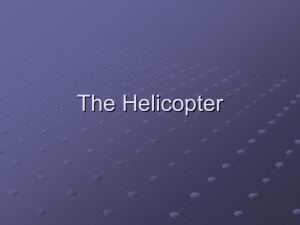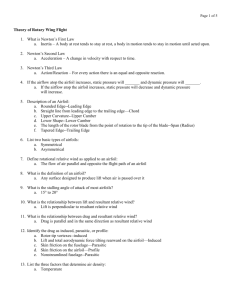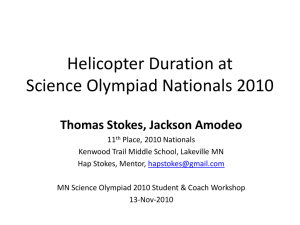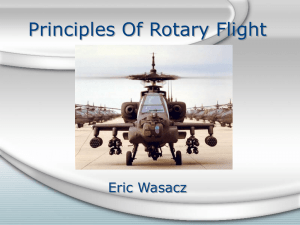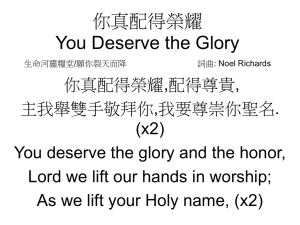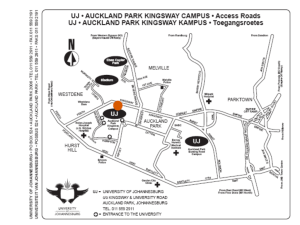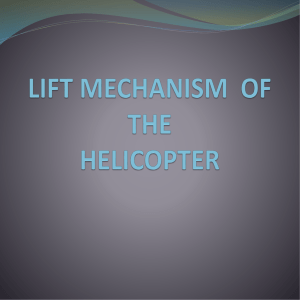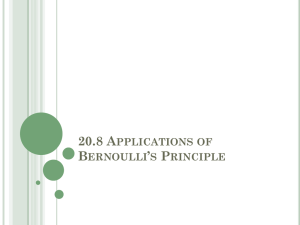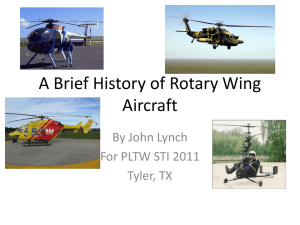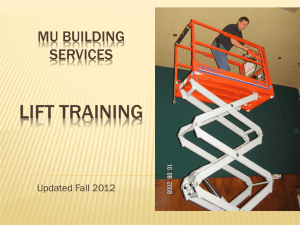PoF LO4
advertisement
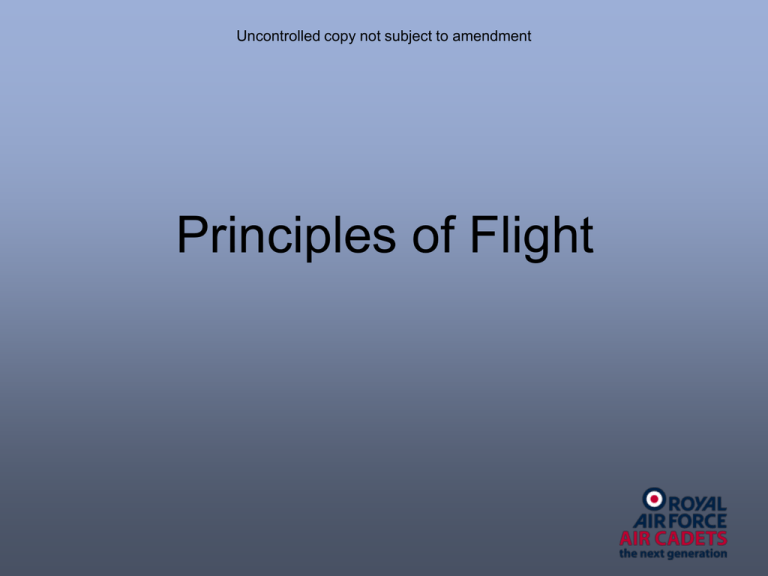
Uncontrolled copy not subject to amendment Principles of Flight Principles of Flight Learning Outcome 5: Be able to apply the principles of flight and control to rotary wing aircraft Part 2 Questions Blade Angle of Attack is between? a. The Chord and Relative Airflow. b. The Rotational Velocity and the Relative Airflow. c. The Total Reaction and the Chord. d. Lift and Drag. Questions Increasing speed with a fixed pitch propeller will? a. Be more efficient. b. Reduce efficiency. c. Make no difference. d. Increase the Engine speed. Questions The Forces trying to alter the Propeller Blade Angle of Attack are? a. ATM and CTM. b. CDM and ATM. c. CTM and REV. d. AOA and ATM. Questions The Resultant Forces that a Propeller produce are? a. Lift and Thrust. b. Thrust and Propeller Rotational Drag . c. Drag and Total Reaction. d. Drag and Thrust. Helicopters Objectives: 1. State the method of generating Lift for a Helicopter. 2. List and Describe the following: • Blades, Rotor Head, Pitch Angle, Collective Pitch, Rotor Disc, Cyclic Pitch, Tail Rotor, Hand Throttle, Torque Reaction. 3. Explain how a Helicopter achieves Horizontal Flight. 4. Describe the Operation of the following Controls: • The Collective. • The Cyclic. • The Yaw Pedals. • The Hand Throttle. Helicopters How does a Wing produce Lift? Do you remember the Wind-Tunnel? Lift A + - B + C Air enters at ‘A’. On reaching ‘B’ it has increased in speed to get through the narrower gap. At ‘C’ the air has returned to the same values as ‘A’. If Speed increases then Pressure Drops & Vice Versa. SO, HOW DOES THIS WORK AS A WING? Lift LIFT A + - B + A Wing works in the same way as the “Wind-Tunnel”. Because the air is faster over the top surface, then the pressure is decreased. The Wing is now producing LIFT. C Helicopters So, instead of moving a Wing through the air, how about we rotate the ‘Wing’! Cross-sectional area of Blade is the same shape as a Wing. The rotating ‘Wing’ is now producing Lift Helicopters How does a Helicopter Climb and Descend? Lift Relative Airflow Angle of Attack Helicopters Climbing – How can the ‘Wing’ produce more Lift? Lift Increase AoA Relative Airflow Angle of Attack Helicopters Descending – How can the ‘Wing’ produce less Lift? Lift Decrease AoA (Increasing or Decreasing Rotor Speed will also affect Lift Production). Parts of a Helicopter Blades Tail Rotor Rotor Head Rotor Disc Parts of a Helicopter HELICOPTER CONTROLS 1. The Collective Pitch Lever. 2. The Hand Throttle. 3. The Cyclic Pitch Control. 4. The Tail Rotor Control (Yaw Pedals). HELICOPTER CONTROLS Controls Cyclic Controls Collective Controls Yaw Pedals Controls Cyclic Collective Yaw Pedals The Hand Throttle Hand Throttle The Collective Pitch Lever often contains a Hand Throttle (like on a motor bike). The Collective Pitch Lever Rotor Blade All Blades are changed by the same Angle. THE COLLECTIVE PITCH LEVER Torque Reaction - Yaw Fuselage Torque Reaction What can be done to stop this? Torque Reaction - Yaw Airflow Balancing Force A Tail Rotor is added to counter the Torque Reaction. Which Control is used for this? The Yaw Pedals Moving the Yaw Pedals will alter Blade Pitch equally on all the Tail Rotor Blades Yaw Pedals The Yaw Pedals can also be used to turn (yaw) the Helicopter around the main Rotor. Tail Rotors Horizontal Flight How does a Helicopter achieve this? Horizontal Flight Lift Lift Thrust Thrust The ‘Disc’ is tilted, producing a horizontal component of Thrust. Horizontal Flight The Rotor Disc can be tilted forward, back, left, right depending on the position of the Cyclic Control. Horizontal Flight Helicopters Objectives: 1. State the method of generating Lift for a Helicopter. 2. List and Describe the following: • Blades, Rotor Head, Pitch Angle, Collective Pitch, Rotor Disc, Cyclic Pitch, Tail Rotor, Hand Throttle, Torque Reaction. 3. Explain how a Helicopter achieves Horizontal Flight. 4. Describe the Operation of the following Controls: • The Collective. • The Cyclic. • The Yaw Pedals. • The Hand Throttle. Questions How does a Helicopter generate Lift? a. Spinning the main rotor faster. b. Spinning the main rotor slower. c. Increasing the angle of attack of each rotor blade. d. Decreasing the angle of attack of each rotor blade. Questions When a Helicopter rotor is driven in a circular motion there is an opposing force, what is this force called? a. Lift. b. Torque Reaction. c. Lift Reaction. d. Drag. Questions What is the purpose of a Tail Rotor? a. Counter Torque Reaction. b. Reduce Drag. c. Provide Thrust. d. Control the Helicopter in the rolling plane. Questions What are the 3 controls a Helicopter uses to control the aircraft’s attitude? a. Collective, Cyclic, Yaw Pedals. b. Ailerons, Rudders. c. Cyclic, Elevators, Throttle. d. Yaw Pedals, Fin, Rotor.
